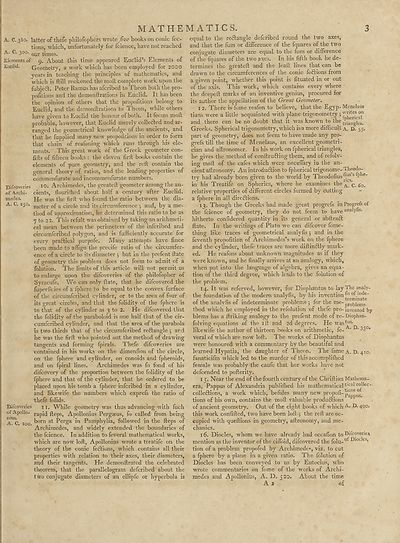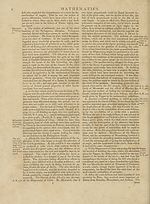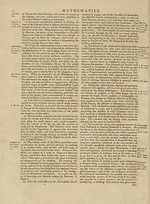Encyclopaedia Britannica, or, a Dictionary of arts, sciences, and miscellaneous literature : enlarged and improved. Illustrated with nearly six hundred engravings > Volume 13, MAT-MIC
(11) Page 3
Download files
Complete book:
Individual page:
Thumbnail gallery: Grid view | List view

3
MATHEMATICS.
A. C. 380. latter of tliefe philofopliers wrote five books on conic fec-
tions, which, unfortunately for fcience, have not reached
A. C. 300. our
Elements of g. About this time appeared Euclid’s Elements of
Eudul. Geometry, a work which has been employed for 2000
years in teaching the principles of mathematics, and
which is ftill reckoned the moll complete work upon the
fubjeft. Peter Ramus has aferibed to Theon both the pro-
pofitions and the demondrations in Euclid. It has been
the opinion of others that the proportions belong to
Euclid, and the demonftrations to Theon, while others
have given to Euclid the honour of both. It fee ms moll
probable, however, that Euclid merely colleded and ar¬
ranged the geometrical knowledge of the ancients, and
that he fupplied many new proportions in order to form
that chain of reafoning which runs through his ele¬
ments. This great work of the Greek geometer con-
lifts of ftfteen books : the eleven ftrft books contain the
elements of pure geometry, and the reft contain the
general theory of ratios, and the leading properties of
commenfurate and incommenfurate numbers.
Dlfcoveries 10- Archimedes, the greateft geometer among the an-
Archi- cients, flourifhed about half a century after Euclid,
inetles. pje was the ftrft who found the ratio between the dia-
A. C. J50. meter 0f a circle and its circumference 5 and, by a me¬
thod of approximation, he determined this ratio to be as
7 to 22. This refult was obtained by taking an arithmeti¬
cal mean between the perimeters of the inferibed and
circumfcribed polygon, and is fufficiently accurate for
every pra&ical purpofe. Many attempts have ftnee
been made to aflign the precife ratio of the circumfer¬
ence of a circle to its diameter *, but in the prefent ftate
of geometry this problem does not feem to admit of a
folution. The limits of this article will not permit us
to enlarge upon the difeoveries of the philofopher of
Syracufe. We can only ftate, that he difeovered the
fuperftcies of a fphere to be equal to the convex furface
of the circumfcribed cylinder, or to the area of four of
its great circles, and that the folidity of the fphere is
to that of the cylinder as 3 to 2. He difeovered that
the folidity of the paraboloid is one half that of the cir¬
cumfcribed cylinder, and that the area of the parabola
is two thirds that of the eircumfcribed re&angle *, and
he was the ftrft who pointed out the method of drawing
tangents and forming fpirals. Thefe difeoveries are
contained in his works on the dimenfton of the circle,
on the fphere and cylinder, on conoids and fpheroids,
and on fpiral lines. Archimedes was fo fond of his
difeovery of the proportion between the folidity of the
fphere and that of the cylinder, that he ordered to be
placed upon his tomb a fphere inferibed in a cylinder,
and likewife the numbers which exprefs the ratio of
thefe folids.
Hifcoveries u. While geometry was thus advancing with fuch
. AP0ll°- rapid fteps, Apollonius Pergaeus, fo called from being
A^C 20c b°rn at Perga in Pamphylia, followed in the fteps of
Archimedes, and Avidely extended the boundaries of
the fcience. In addition to feveral mathematical works,
which are now loft, Apollonius wrote a treatife on the
theory of the conic fettions, which contains all their
properties with relation to their axes, their diameters,
and their tangents. He demonftrated the celebrated
theorem, that the parallelogram deferibed about the
two conjugate diameters of an ellipfe or hyperbola is
equal to the rectangle deferibed round the two axes,
and that the fum or difference of the fquares of the two
conjugate diameters are equal to the fum or difference
of the fquares of the two axes. In his fifth book he de¬
termines the greateft and the leaft lines that can be
drawn to the circumferences of the conic fe&ions from
a given point, whether this point is fituated in or out
of the axis. This work, which contains every where
the deepeft marks of an inventive genius, procured for
its author the appellation of the Great Geo?neter.
12. There is fome reafon to believe, that the Egyp-Mcnelaus
tians were a little acquainted with plane trigonometry 5
and there can be no doubt that it was known to the
Greeks. Spherical trigonometry, Avhich is a more difficult a. D. 55.
part of geometry, does not feem to have made any pro-
grefs till the time of Menelaus, an excellent geometri¬
cian and aftronomer. In his work on fpherical triangles,
he gives the method of conftrufting them, and of refolv-
ing moft of the cafes wffiich were neceffary in the an¬
cient aftronomy. An introduction to fpherical trigonome- Theodo-
try had already been given to the world by Theodofius'ftus s ^IC"
in his Treatife on Spherics, where he examines the ^ ‘c
relative properties of different circles formed by cutting
a fphere in all directions.
13. Though the Greeks had made great progrefs in Progrefs of
the fcience of geometry, they do not feem to haveanabfts-
hitherto conftdered quantity in its general or abftraCt
ftate. In the writings of Plato wTe can difeover fome-
thing like traces of geometrical analyfis; and in the
feventh propofitien of Archimedes’s work on the fphere
and the cylinder, thefe traces are more diftinftly mark¬
ed. He reafons about unknown magnitudes as if they
were known, and he finally arrives at an analogy, which,
■when put into the language of algebra, gives an equa¬
tion of the third degree, which leads to the folution of
the problem.
14. It was referved, however, for Diophantus to lay The analy-
the foundation of the modem analyfis, by his invention
of the analyfis of indeterminate problems •, for the me- probiems
thod which he employed in the refolution of thefe pro- invented by
blems has a ftriking analogy to the prefent mode of re- Diophan-
folving equations of the iff and 2d degrees. He was^s-
likewife the author of thirteen books on arithmetic, fe- ‘ •’^c‘
veral of which are now loft. The works of Diophantus
were honoured with a commentary by the beautiful and
learned Hypatia, the daughter of Theon. The fame a. D. 410.
fanaticifm which led to the murder of this aceompliftied
female was probably the caufe that her works have not
defeended to pofterity.
15. Near the end of the fourth century of the Chriftian Mathema-
era, Pappus of Alexandria publiffied his mathematical c<^ec*
collections, a work which, befides many new propofi-
tions of his own, contains the moft valuable productions
of ancient geometry. Out of the eight books of which 400*
this work confifted, two have been lofty the reft are oc¬
cupied with queftions in geometry, aftronomy, and me¬
chanics.
16. Diodes, whom we have already had occafion to Difcovene*
mention as the inventor of the ciffoid, difeovered the folu- o!~ •^^oc^cs»
tion of a problem propofed by Archimedes, viz. to cut
a fphere by a plane in a given ratio. The folution of
Diodes has been conveyed to us by Eutocius, who
wrote commentaries on fome of the works of Archi¬
medes and Apollonius, A. D. 5 20. About the time
A 2 of
MATHEMATICS.
A. C. 380. latter of tliefe philofopliers wrote five books on conic fec-
tions, which, unfortunately for fcience, have not reached
A. C. 300. our
Elements of g. About this time appeared Euclid’s Elements of
Eudul. Geometry, a work which has been employed for 2000
years in teaching the principles of mathematics, and
which is ftill reckoned the moll complete work upon the
fubjeft. Peter Ramus has aferibed to Theon both the pro-
pofitions and the demondrations in Euclid. It has been
the opinion of others that the proportions belong to
Euclid, and the demonftrations to Theon, while others
have given to Euclid the honour of both. It fee ms moll
probable, however, that Euclid merely colleded and ar¬
ranged the geometrical knowledge of the ancients, and
that he fupplied many new proportions in order to form
that chain of reafoning which runs through his ele¬
ments. This great work of the Greek geometer con-
lifts of ftfteen books : the eleven ftrft books contain the
elements of pure geometry, and the reft contain the
general theory of ratios, and the leading properties of
commenfurate and incommenfurate numbers.
Dlfcoveries 10- Archimedes, the greateft geometer among the an-
Archi- cients, flourifhed about half a century after Euclid,
inetles. pje was the ftrft who found the ratio between the dia-
A. C. J50. meter 0f a circle and its circumference 5 and, by a me¬
thod of approximation, he determined this ratio to be as
7 to 22. This refult was obtained by taking an arithmeti¬
cal mean between the perimeters of the inferibed and
circumfcribed polygon, and is fufficiently accurate for
every pra&ical purpofe. Many attempts have ftnee
been made to aflign the precife ratio of the circumfer¬
ence of a circle to its diameter *, but in the prefent ftate
of geometry this problem does not feem to admit of a
folution. The limits of this article will not permit us
to enlarge upon the difeoveries of the philofopher of
Syracufe. We can only ftate, that he difeovered the
fuperftcies of a fphere to be equal to the convex furface
of the circumfcribed cylinder, or to the area of four of
its great circles, and that the folidity of the fphere is
to that of the cylinder as 3 to 2. He difeovered that
the folidity of the paraboloid is one half that of the cir¬
cumfcribed cylinder, and that the area of the parabola
is two thirds that of the eircumfcribed re&angle *, and
he was the ftrft who pointed out the method of drawing
tangents and forming fpirals. Thefe difeoveries are
contained in his works on the dimenfton of the circle,
on the fphere and cylinder, on conoids and fpheroids,
and on fpiral lines. Archimedes was fo fond of his
difeovery of the proportion between the folidity of the
fphere and that of the cylinder, that he ordered to be
placed upon his tomb a fphere inferibed in a cylinder,
and likewife the numbers which exprefs the ratio of
thefe folids.
Hifcoveries u. While geometry was thus advancing with fuch
. AP0ll°- rapid fteps, Apollonius Pergaeus, fo called from being
A^C 20c b°rn at Perga in Pamphylia, followed in the fteps of
Archimedes, and Avidely extended the boundaries of
the fcience. In addition to feveral mathematical works,
which are now loft, Apollonius wrote a treatife on the
theory of the conic fettions, which contains all their
properties with relation to their axes, their diameters,
and their tangents. He demonftrated the celebrated
theorem, that the parallelogram deferibed about the
two conjugate diameters of an ellipfe or hyperbola is
equal to the rectangle deferibed round the two axes,
and that the fum or difference of the fquares of the two
conjugate diameters are equal to the fum or difference
of the fquares of the two axes. In his fifth book he de¬
termines the greateft and the leaft lines that can be
drawn to the circumferences of the conic fe&ions from
a given point, whether this point is fituated in or out
of the axis. This work, which contains every where
the deepeft marks of an inventive genius, procured for
its author the appellation of the Great Geo?neter.
12. There is fome reafon to believe, that the Egyp-Mcnelaus
tians were a little acquainted with plane trigonometry 5
and there can be no doubt that it was known to the
Greeks. Spherical trigonometry, Avhich is a more difficult a. D. 55.
part of geometry, does not feem to have made any pro-
grefs till the time of Menelaus, an excellent geometri¬
cian and aftronomer. In his work on fpherical triangles,
he gives the method of conftrufting them, and of refolv-
ing moft of the cafes wffiich were neceffary in the an¬
cient aftronomy. An introduction to fpherical trigonome- Theodo-
try had already been given to the world by Theodofius'ftus s ^IC"
in his Treatife on Spherics, where he examines the ^ ‘c
relative properties of different circles formed by cutting
a fphere in all directions.
13. Though the Greeks had made great progrefs in Progrefs of
the fcience of geometry, they do not feem to haveanabfts-
hitherto conftdered quantity in its general or abftraCt
ftate. In the writings of Plato wTe can difeover fome-
thing like traces of geometrical analyfis; and in the
feventh propofitien of Archimedes’s work on the fphere
and the cylinder, thefe traces are more diftinftly mark¬
ed. He reafons about unknown magnitudes as if they
were known, and he finally arrives at an analogy, which,
■when put into the language of algebra, gives an equa¬
tion of the third degree, which leads to the folution of
the problem.
14. It was referved, however, for Diophantus to lay The analy-
the foundation of the modem analyfis, by his invention
of the analyfis of indeterminate problems •, for the me- probiems
thod which he employed in the refolution of thefe pro- invented by
blems has a ftriking analogy to the prefent mode of re- Diophan-
folving equations of the iff and 2d degrees. He was^s-
likewife the author of thirteen books on arithmetic, fe- ‘ •’^c‘
veral of which are now loft. The works of Diophantus
were honoured with a commentary by the beautiful and
learned Hypatia, the daughter of Theon. The fame a. D. 410.
fanaticifm which led to the murder of this aceompliftied
female was probably the caufe that her works have not
defeended to pofterity.
15. Near the end of the fourth century of the Chriftian Mathema-
era, Pappus of Alexandria publiffied his mathematical c<^ec*
collections, a work which, befides many new propofi-
tions of his own, contains the moft valuable productions
of ancient geometry. Out of the eight books of which 400*
this work confifted, two have been lofty the reft are oc¬
cupied with queftions in geometry, aftronomy, and me¬
chanics.
16. Diodes, whom we have already had occafion to Difcovene*
mention as the inventor of the ciffoid, difeovered the folu- o!~ •^^oc^cs»
tion of a problem propofed by Archimedes, viz. to cut
a fphere by a plane in a given ratio. The folution of
Diodes has been conveyed to us by Eutocius, who
wrote commentaries on fome of the works of Archi¬
medes and Apollonius, A. D. 5 20. About the time
A 2 of
Set display mode to:
![]() Universal Viewer |
Universal Viewer | ![]() Mirador |
Large image | Transcription
Mirador |
Large image | Transcription
Images and transcriptions on this page, including medium image downloads, may be used under the Creative Commons Attribution 4.0 International Licence unless otherwise stated. ![]()
| Permanent URL | https://digital.nls.uk/192661305 |
|---|
| Attribution and copyright: |
|
|---|
| Description | Ten editions of 'Encyclopaedia Britannica', issued from 1768-1903, in 231 volumes. Originally issued in 100 weekly parts (3 volumes) between 1768 and 1771 by publishers: Colin Macfarquhar and Andrew Bell (Edinburgh); editor: William Smellie: engraver: Andrew Bell. Expanded editions in the 19th century featured more volumes and contributions from leading experts in their fields. Managed and published in Edinburgh up to the 9th edition (25 volumes, from 1875-1889); the 10th edition (1902-1903) re-issued the 9th edition, with 11 supplementary volumes. |
|---|---|
| Additional NLS resources: |
|

